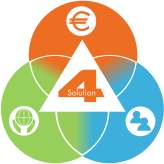What is the MATERIALITY ANALYSIS?

A materiality analysis, also known as a materiality assessment, is an essential process for companies to identify and evaluate the most important topics and stakeholder requirements in the area of sustainability.
This analysis forms the basis for a company’s sustainability strategy and reporting.
The materiality analysis is used to identify the most significant economic, environmental and social topics that are relevant to both the company and its stakeholders.
These issues are prioritized in order to deploy resources efficiently and make strategic decisions.
PROCESS of the materiality analysis
Who is OBLIGED?
The method is particularly important for companies that have to report in accordance with CSR guidelines, such as the Due Diligence Act or the Code of Conduct.
It is used in various industries, especially those that are required to carry out sustainability reporting.
The materiality analysis is an important element of the sustainability report, which will be mandatory for many companies from 2024 and must be carried out annually in accordance with the Corporate Sustainability Reporting Directive (CSRD).
Large companies that are required to report under the CSRD Large companies that are required to report in accordance with the Corporate Sustainability Reporting Directive (CSRD).
The CSRD replaces the previous Non-Financial Reporting Directive (NFRD) and expands the group of companies subject to reporting requirements.
Reporting obligation in 2025, for the data year 2024.
Companies with more than 250 employees Uompanies that are subject to the Corporate Sustainability Reporting Directive (CSRD) are companies that fulfill at least two of the following three criteria: – More than 250 employees.
– More than 50 million euros in turnover.
– More than 25 million euros in total assets Mandatory reporting in 2026, for the data year 2025.
Smaller listed companies Smaller, listed SMEs are affected.
Mandatory reporting in 2027, for the data year 2026.
Companies that already report in accordance with the Global Reporting Initiative (GRI).
CHALLENGES to the MATERIALITY ANALYSIS
As with all other components of ESG reporting, the materiality analysis often faces the same challenges with its central role in reporting.
These can be, for example, the following focal points:
Materiality analysis is therefore a complex but crucial process for sustainability reporting and the strategic orientation of a company.
By applying structured methods, transparent criteria and continuous stakeholder communication, most challenges can be overcome effectively.
SOLUTION of the ESSENTIALITY ANALYSIS in SOLUTION4
In order to meet the challenges of materiality analysis, there are extensive integrated modules for green controlling.
The materiality analysis module enables a comprehensive assessment and simulation of sustainability aspects.
The software, supplemented by accompanying consulting from our partner Licennium, thus helps to carry out the materiality analysis in an audit-proof manner.
The AEP Solution4 materiality analysis module in AEP Solution4 enables the user to carry out a comprehensive assessment of sustainability aspects.
All aspects to be considered are listed in an outline tree.
Colored markers indicate the processing status of the tasks.
The materiality analysis activities can be assigned, scheduled and prioritized via a workflow to those responsible and task owners.
An interactive self-assessment module enables various stakeholders of the company to participate in the assessment of sustainability aspects.
The results of the stakeholder analysis can be evaluated in clear dashboards and graphics and used for further process steps in the materiality analysis.
The user receives support in finding ideas and suggestions for the description of impacts (inside-out) and opportunities/risks (outside-in) and can simulate these in advance.

















